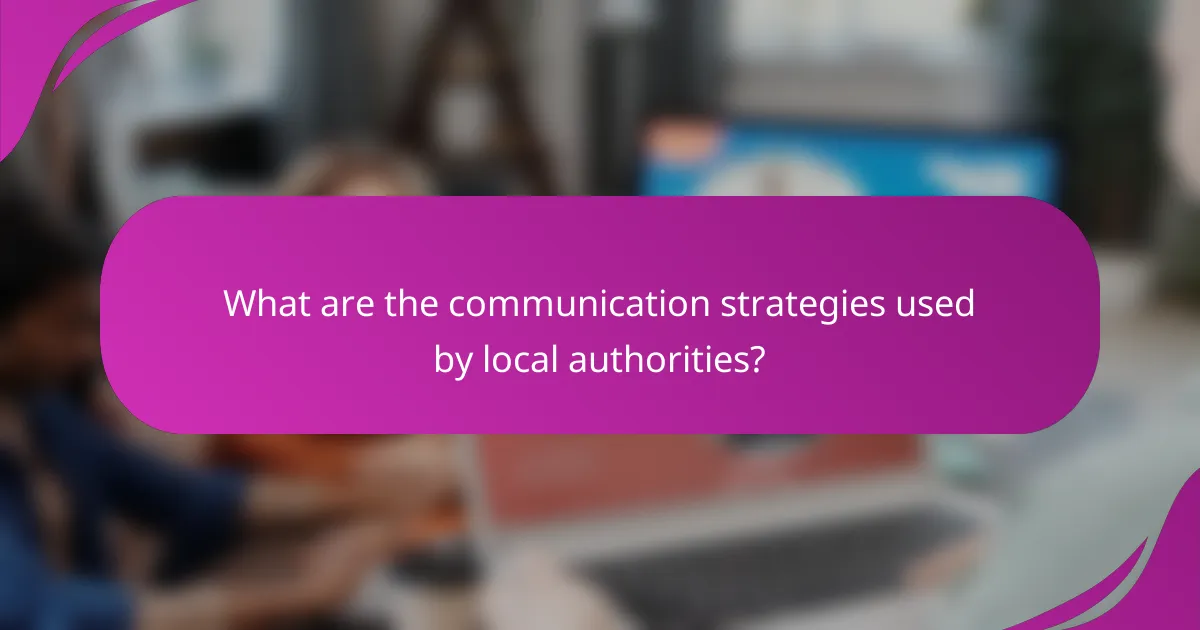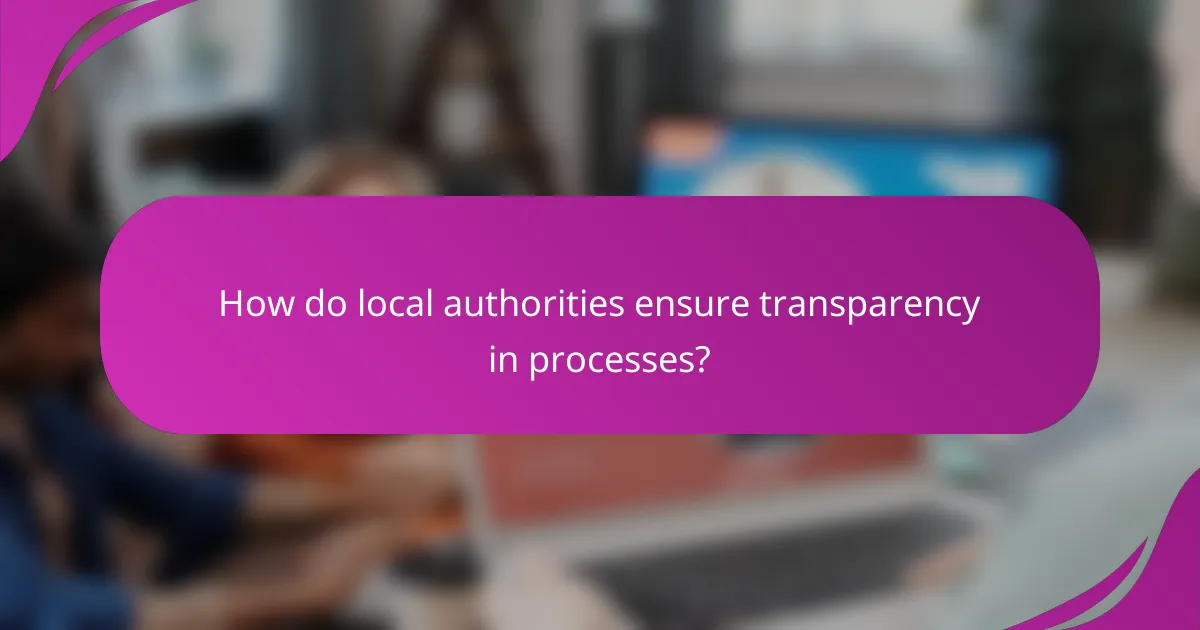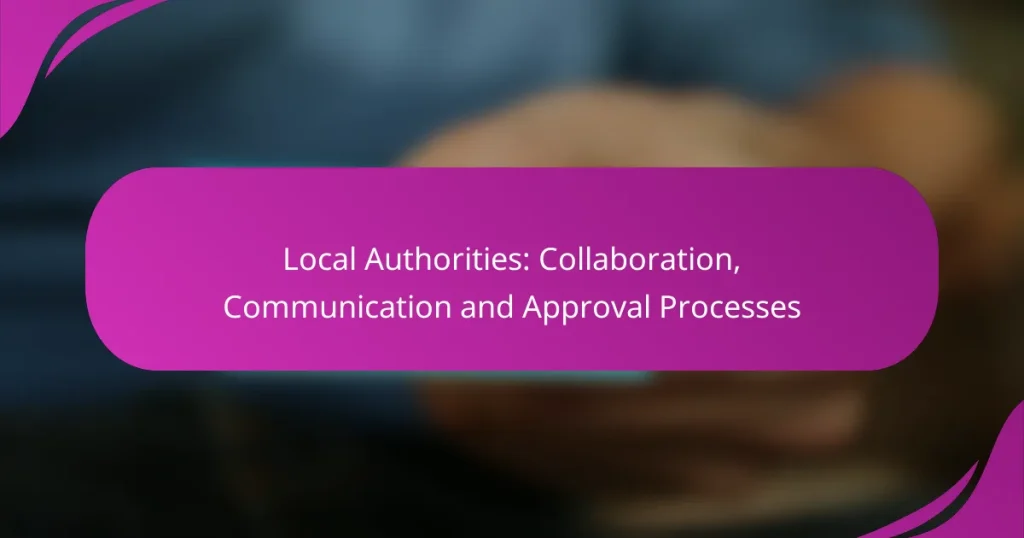Local authorities play a crucial role in fostering collaboration and communication within communities, utilizing structured methods to enhance service delivery and well-being. Through inter-agency partnerships and community engagement initiatives, they address specific local needs while ensuring transparency via public information campaigns and forums. The approval processes for local projects are meticulously designed to comply with regulations and community standards, involving permit applications and public consultations that promote effective dialogue between developers and authorities.

How do local authorities collaborate in Canada?
Local authorities in Canada collaborate through various structured methods to enhance service delivery and community well-being. This collaboration often involves inter-agency partnerships, community engagement initiatives, and joint task forces, each designed to address specific local needs effectively.
Inter-agency partnerships
Inter-agency partnerships involve multiple government departments or agencies working together to achieve common goals. These collaborations can streamline processes, reduce duplication of efforts, and improve resource allocation. For example, a health department might partner with housing authorities to address homelessness by providing health services in shelters.
Effective inter-agency partnerships require clear communication and defined roles among the involved parties. Regular meetings and shared objectives help maintain alignment and accountability, ensuring that all agencies contribute to the partnership’s success.
Community engagement initiatives
Community engagement initiatives are essential for local authorities to understand the needs and preferences of residents. These initiatives can take various forms, including public consultations, surveys, and community forums. Engaging with the community fosters trust and encourages participation in local governance.
Local authorities should prioritize transparency and accessibility in their engagement efforts. Utilizing social media and local events can enhance outreach, ensuring that diverse community voices are heard and considered in decision-making processes.
Joint task forces
Joint task forces are temporary groups formed to tackle specific issues that require coordinated efforts from multiple agencies. These task forces can address challenges such as public safety, environmental concerns, or emergency response. By pooling resources and expertise, task forces can implement solutions more effectively than individual agencies could alone.
To maximize the effectiveness of joint task forces, it is crucial to establish clear objectives, timelines, and evaluation criteria. Regular assessments of progress and outcomes help ensure that the task force remains focused and can adapt to changing circumstances or emerging challenges.

What are the communication strategies used by local authorities?
Local authorities employ various communication strategies to engage with the public and ensure transparency. These strategies include public information campaigns, social media outreach, and community forums, each designed to facilitate effective communication and foster community involvement.
Public information campaigns
Public information campaigns are structured efforts to inform citizens about important issues, services, or events. These campaigns often utilize brochures, flyers, and local media to disseminate information widely.
For effective campaigns, local authorities should focus on clear messaging and target specific demographics. Utilizing local languages and culturally relevant content can enhance engagement and understanding.
Social media outreach
Social media outreach allows local authorities to connect with residents in real-time and share updates instantly. Platforms like Facebook, Twitter, and Instagram are commonly used to post news, respond to inquiries, and promote community events.
To maximize impact, authorities should maintain a consistent posting schedule and engage with followers through comments and messages. Monitoring social media analytics can help refine strategies and improve outreach efforts.
Community forums
Community forums provide a platform for residents to voice concerns, ask questions, and participate in discussions about local issues. These forums can be held in person or online, allowing for broader participation.
Local authorities should ensure that forums are accessible and inclusive, offering translation services if necessary. Gathering feedback during these sessions can guide decision-making and strengthen community trust.

What are the approval processes for local projects?
The approval processes for local projects typically involve several key steps that ensure compliance with regulations and community standards. These processes often include permit applications, public consultations, and regulatory compliance checks, which together facilitate effective communication between project developers and local authorities.
Permit application procedures
Permit application procedures vary by locality but generally require the submission of detailed plans and documentation outlining the project. Applicants must provide information such as site plans, environmental assessments, and construction timelines.
It’s crucial to check local regulations for specific requirements, as some areas may have additional stipulations, such as zoning approvals or special use permits. Delays can occur if applications are incomplete or if additional information is requested by the authorities.
Public consultation requirements
Public consultation requirements are designed to involve community members in the decision-making process. Many local authorities mandate public meetings or forums where residents can express their opinions and concerns regarding proposed projects.
These consultations may require advance notice and can take various forms, such as open houses, surveys, or formal hearings. Engaging with the community early can help identify potential issues and foster support for the project.
Regulatory compliance checks
Regulatory compliance checks ensure that projects adhere to local, state, and federal laws. This may involve inspections by various agencies to verify that the project meets safety, environmental, and zoning standards.
It’s advisable to familiarize yourself with relevant regulations and to maintain open communication with regulatory bodies throughout the project. Non-compliance can lead to fines, project delays, or even the revocation of permits, making it essential to prioritize adherence to all applicable standards.

What criteria influence collaboration and communication?
Collaboration and communication among local authorities are influenced by several key criteria, including stakeholder involvement, resource availability, and policy alignment. Understanding these factors can enhance the effectiveness of local governance and improve project outcomes.
Stakeholder involvement
Effective collaboration requires active participation from all relevant stakeholders, including government agencies, community groups, and private sector partners. Engaging stakeholders early in the process helps to identify needs, gather diverse perspectives, and foster a sense of ownership over outcomes.
To ensure comprehensive involvement, local authorities should establish clear channels for communication and feedback. Regular meetings, surveys, and public forums can facilitate ongoing dialogue and address concerns promptly.
Resource availability
Resource availability plays a crucial role in determining the extent and quality of collaboration. This includes financial resources, human capital, and technological tools necessary for effective communication and project execution. Limited resources can hinder collaboration efforts and lead to suboptimal outcomes.
Local authorities should assess their resource capabilities and seek partnerships or funding opportunities to bolster their efforts. For instance, leveraging grants or collaborating with non-profits can provide additional support for community initiatives.
Policy alignment
Alignment of policies across different local authorities and stakeholders is essential for cohesive collaboration. When policies are inconsistent or conflicting, it can create barriers to communication and hinder joint efforts. Establishing common goals and shared objectives can help align policies effectively.
Local authorities should regularly review and update their policies to ensure they reflect current needs and priorities. Engaging in inter-agency discussions can also facilitate alignment and promote a unified approach to community challenges.

How do local authorities ensure transparency in processes?
Local authorities ensure transparency in their processes by implementing various strategies that promote openness and accountability. These strategies include open data initiatives, regular reporting, and providing public access to meeting minutes, all of which help citizens stay informed and engaged.
Open data initiatives
Open data initiatives involve local authorities making datasets publicly available in accessible formats. This practice allows citizens, researchers, and businesses to analyze information related to public services, budgets, and community demographics. For instance, a city might publish its budget data online, enabling residents to see how funds are allocated and spent.
To maximize the impact of open data, local authorities should ensure that the datasets are regularly updated and easy to navigate. Providing user-friendly tools for data visualization can further enhance public engagement and understanding.
Regular reporting
Regular reporting is a key aspect of maintaining transparency, as it keeps the public informed about ongoing projects and initiatives. Local authorities typically publish reports on their activities, performance metrics, and financial status at set intervals, such as quarterly or annually. These reports can include information on service delivery, community engagement efforts, and future plans.
To improve the effectiveness of regular reporting, authorities should focus on clarity and accessibility. Using plain language and visual aids, such as charts and graphs, can help convey complex information in a straightforward manner.
Public access to meeting minutes
Providing public access to meeting minutes allows citizens to review discussions and decisions made by local authorities. This practice fosters accountability and encourages community involvement in governance. Meeting minutes should be made available shortly after meetings, ideally in a digital format that is easy to search and navigate.
Local authorities can enhance transparency by summarizing key points and decisions in their meeting minutes. Including action items and responsible parties can further clarify the outcomes and next steps, making it easier for the public to track progress on important issues.


